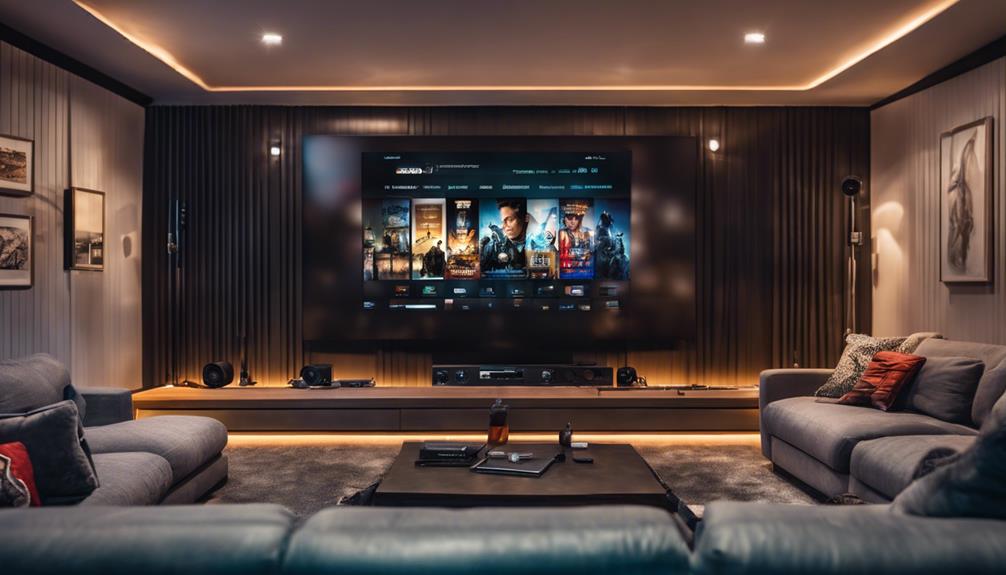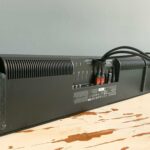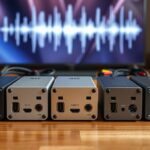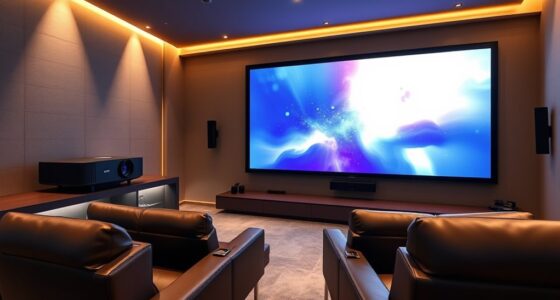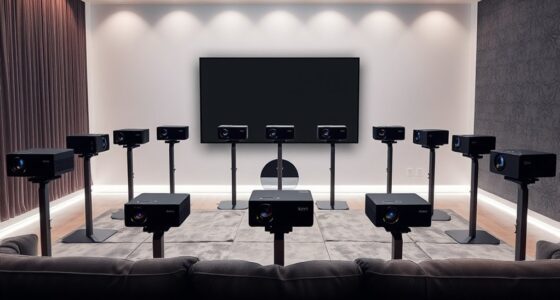I've explored the top HDMI audio extractors of 2025, which can elevate your home theater experience. The J-Tech Digital 4K extractor offers 4K support and excellent audio quality, while the OREI 8K model accommodates advanced formats like Dolby Atmos. Other strong contenders include the Amazon Basics extractor for plug-and-play convenience and the Tendak model with customizable audio modes. Many options support both 4K@30Hz and 60Hz resolutions, enhancing video quality. Consider factors such as audio output compatibility and ease of setup when selecting the best unit for your setup. You'll find even more details on these devices ahead.
Key Takeaways
- The best HDMI audio extractors support high video resolutions, with many models offering 4K at 60Hz for optimal viewing experiences.
- Look for extractors with multiple audio output options, including optical, RCA, and 3.5mm, to ensure compatibility with your audio system.
- Advanced models support various audio formats such as Dolby Atmos, DTS:X, and Dolby Digital for enhanced sound quality.
- Installation should be straightforward with plug-and-play designs, while USB power supply may be necessary for some devices.
J-Tech Digital 4K 60Hz HDMI Audio Extractor Converter

If you're looking for a reliable way to extract high-quality audio from your HDMI devices, the J-Tech Digital 4K 60Hz HDMI Audio Extractor Converter is an excellent choice.
This compact device measures just 2.9 x 2.6 x 0.6 inches and weighs 8.4 ounces, making it easy to integrate into your home theater setup. It supports a range of video resolutions, including 4K at 60Hz, ensuring you get the best picture quality.
The extractor converts HDMI audio to both 2-channel analog stereo and multi-channel SPDIF output, allowing for versatile audio setups. Users appreciate its effortless installation and solid performance, particularly with surround sound systems.
However, it's important to configure your HDMI source settings properly to maximize audio output.
Best For: Users seeking a compact solution to extract high-quality audio from HDMI devices for their home theater systems.
Pros:
- Supports multiple audio formats including 2-channel analog stereo and multi-channel SPDIF output for versatile audio setups.
- Compatible with high video resolutions up to 4K at 60Hz, ensuring excellent picture quality.
Cons:
- Limited to 5.1 channel audio output, which may not meet the needs of users requiring higher multi-channel audio formats.
- Does not support ARC function, limiting some audio return capabilities from TVs.
HDMI Audio Extractor 4K HDMI to Optical and AUX Adapter Splitter Converter

The HDMI Audio Extractor 4K HDMI to Optical and AUX Adapter Splitter Converter is the perfect solution for anyone looking to connect modern HDMI devices to older audio receivers without sacrificing sound quality.
This extractor allows you to extract audio from an HDMI signal and transmit it to your AV receiver via optical or 3.5mm cable. It supports three modes: 2.0CH for stereo output, 5.1CH for optical output, and PASS mode for versatile connectivity.
With 4K Ultra-HD capabilities and low energy consumption, it's both efficient and effective. Installation is straightforward, thanks to its plug-and-play design.
While most users appreciate its performance, some have faced initial setup challenges. Overall, this extractor is a practical choice for enhancing your home theater experience.
Best For: Those looking to connect modern HDMI devices to older audio receivers without compromising audio quality.
Pros:
- Supports multiple audio formats including 2.0CH and 5.1CH for versatile use.
- 4K Ultra-HD capability ensures high-quality video transmission.
Cons:
- Initial setup challenges can lead to confusion, particularly with audio routing.
- Mixed reviews on customer support availability and effectiveness.
DONGJIAN HDMI Audio Extractor, 4K HDMI to HDMI with Audio Out

For anyone looking to enhance their audio experience while using older monitors or devices without built-in speakers, the DONGJIAN HDMI Audio Extractor stands out with its ability to convert HDMI signals into high-quality audio output.
This device features one HDMI input, one HDMI output, and a 3.5mm stereo audio output, allowing me to connect to amplifiers or soundbars easily. It supports various formats, including 4K at 30Hz, 3D, and 1080p, making it versatile for different devices like Roku and Blu-ray players.
Installation is straightforward—just connect the HDMI and audio cables. While it generally receives positive feedback for audio quality, some users mention issues with cable connections.
Overall, it's a solid choice for enhancing audio from HDMI sources.
Best For: Those seeking to extract high-quality audio from HDMI sources for older monitors or devices lacking built-in speakers.
Pros:
- Easy installation with straightforward HDMI and audio cable connections.
- Supports a wide range of video formats, including 4K at 30Hz and 3D, making it versatile for various devices.
Cons:
- Issues with physical design, particularly concerning cable connections reported by some users.
- Occasional compatibility problems with specific devices or use cases.
HDMI Audio Extractor, 4K HDMI to HDMI Splitter

Offering seamless audio extraction from HDMI sources, the HDMI Audio Extractor is perfect for anyone wanting to enhance their audio experience while using devices like gaming consoles and Blu-ray players.
This extractor converts HDMI input to both HDMI output and R/L analog audio output, making it versatile for various uses. It supports input resolutions up to 1080P, which is adequate for many users.
However, I've noticed that while the audio quality is listenable, it doesn't reach high-definition levels. The extractor requires external power for peak performance, and I found compatibility can be hit or miss with certain devices.
Overall, it's a useful tool, especially for setups needing audio separation, but be aware of potential video quality degradation.
Best For: Users looking to enhance their audio experience while connecting devices like gaming consoles and Blu-ray players to displays without audio support.
Pros:
- Supports multiple devices including TVs, gaming consoles, and projectors for versatile use.
- Extracts audio effectively from HDMI sources, allowing for improved sound beyond built-in TV speakers.
Cons:
- Audio quality is only listenable and does not reach high-definition levels, which may disappoint audiophiles.
- Compatibility issues may arise with certain TVs, leading to potential frustrations during setup.
avedio links 4K HDMI Audio Extractor Splitter

Designed to seamlessly extract digital audio from HDMI sources, the avedio links 4K HDMI Audio Extractor Splitter is perfect for anyone looking to enhance their home audio experience without breaking the bank.
It supports video resolutions up to 4K@30Hz and various audio formats, including DTS-HD and Dolby TrueHD. With three audio modes—PASS, 2CH, and 5.1CH—I can easily tailor the sound to my setup.
This compact device works with multiple HDMI gadgets, from Blu-ray players to gaming consoles, offering versatility for my home theater. Users praise its audio synchronization and simple setup, although some have reported minor issues with optical audio connections.
Overall, it's a cost-effective solution for achieving high-quality audio in any media environment.
Best For: Those seeking a budget-friendly solution to extract high-quality audio from various HDMI devices for an enhanced home theater experience.
Pros:
- High compatibility with multiple HDMI devices, including gaming consoles and Blu-ray players.
- Supports a range of audio formats and offers three audio mode options for tailored sound.
Cons:
- Some users have experienced issues with loose connections, particularly with optical audio ports.
- Occasional reports of audio output ceasing unexpectedly.
OREI 8K Audio Extractor HDMI Converter (BKA-1)

The OREI 8K Audio Extractor HDMI Converter (BKA-1) stands out as the perfect choice for gamers and home theater enthusiasts who demand high-resolution audio and video performance, supporting up to 8K at 60Hz and a variety of advanced audio formats.
This device features one HDMI input and multiple outputs, including HDMI ARC, L/R audio, and Optical S/PDIF. It's compatible with popular gaming consoles like PS5 and Xbox, making it versatile for any setup.
The build quality is impressive, constructed from heavy-duty metal for durability.
However, it doesn't support eARC, which limits volume control through the TV remote. Users generally report a stable connection, but some have noted issues with high-rate audio compatibility.
Best For: Home theater enthusiasts and gamers seeking high-resolution audio and video performance with versatile connectivity options.
Pros:
- Supports high resolutions up to 8K @ 60Hz and a variety of advanced audio formats including Dolby Atmos and DTS:X.
- Durable build quality with a heavy-duty metal enclosure for enhanced longevity and heat dissipation.
Cons:
- Does not support eARC, limiting volume control through the TV remote.
- Compatibility issues may arise with certain devices, such as Apple TV.
Amazon Basics 4K HDMI to HDMI and Audio Extractor Converter

For users with older audio equipment that lacks HDMI compatibility, the Amazon Basics 4K HDMI to HDMI and Audio Extractor Converter provides a seamless solution for high-quality audio extraction.
This device supports a variety of HDMI source devices, including Blu-ray players and gaming consoles, making it versatile for different setups. It features durable metal housing and delivers video resolutions up to 4K at 30 Hz. The default audio setting is 2.0 channel, but it also supports 5.1 channel audio through Toslink and coaxial outputs.
Users appreciate its plug-and-play functionality and solid construction. However, some have reported synchronization issues when using dual audio outputs, so adjusting settings may be necessary for peak performance.
Overall, it's a reliable choice for enhancing audio experiences.
Best For: Users with older audio equipment lacking HDMI compatibility who want to extract high-quality audio from various HDMI source devices.
Pros:
- Durable metal housing ensures longevity and reliable performance.
- Versatile compatibility with multiple devices, including Blu-ray players and gaming consoles.
Cons:
- Some users experience synchronization issues when using dual audio outputs.
- Requires adjustments in audio settings for optimal performance, particularly with Apple TV.
Tendak 4K HDMI Audio Extractor and Converter

With its ability to support up to 4K resolution and multiple audio output options, the Tendak 4K HDMI Audio Extractor and Converter is perfect for anyone looking to enhance their home theater experience without the hassle of additional power supplies or drivers.
This device easily connects your HDMI source to a high-definition display while transmitting audio to speakers or amplifiers through optical, coaxial, or 3.5mm ports.
It supports various video formats, including 3D and Deep Color, ensuring compatibility with a range of devices like Roku, Blu-ray players, and gaming consoles.
The adjustable audio modes—2.0CH, 5.1CH, and TV—allow for a customized audio experience.
Overall, it's a user-friendly solution for anyone wanting quality audio without complexity.
Best For: Those seeking an easy-to-use audio extractor that enhances their home theater experience with 4K video support and multiple audio output options.
Pros:
- Plug and Play design allows for straightforward setup without additional power supplies or drivers.
- Supports a wide range of audio formats including DTS-HD and Dolby Digital, ensuring compatibility with various systems.
Cons:
- Limited to 30Hz at 4K resolution, which may not satisfy users looking for higher refresh rates.
- No ARC function support, restricting audio transmission without HDMI connections.
OREI HDA-912 4K HDMI Audio Converter Extractor

Offering versatile audio output options, the OREI HDA-912 4K HDMI Audio Converter Extractor is perfect for anyone looking to connect modern HDMI devices to older sound systems.
This compact unit features SPDIF, 3.5mm, and L/R audio outputs, allowing for seamless integration with various audio setups.
Supporting up to 4K at 60Hz, it handles multiple audio formats, including Dolby Atmos and DTS:X, ensuring high-quality sound for gaming consoles and streaming devices.
While its metal build enhances durability, some users have reported occasional audio delays and background noise.
With a solid 4.2-star rating from over 1,000 customers, the OREI HDA-912 is a reliable choice for enhancing your home theater experience.
Plus, it comes with a 12-month warranty and lifetime tech support.
Best For: Users seeking to connect modern HDMI devices to older audio systems while maintaining high-quality sound.
Pros:
- Pros: Compact design allows for easy plug & play installation.
- Pros: Supports a wide range of audio formats, including Dolby Atmos and DTS:X.
Cons:
- Cons: Some users report occasional audio delays in specific setups.
- Cons: A slight humming noise has been noted by certain customers.
eSynic Portable HDMI Audio Extractor 4K

The eSynic Portable HDMI Audio Extractor 4K is perfect for anyone wanting to enjoy high-fidelity audio from their favorite streaming devices or gaming consoles without complicated setups.
This extractor effortlessly extracts audio from HDMI sources like Blu-ray players and gaming consoles, sending it to audio systems via optical output. It supports stunning visuals up to 4K@30Hz and various resolutions, guaranteeing a clear video passthrough.
While it's compatible with Dolby/DTS 5.1 audio formats, it doesn't support 7.1 surround sound or ARC/eARC features.
The plug-and-play functionality makes installation a breeze, and the included cables guarantee you have everything needed for setup.
Overall, the eSynic offers good audio quality, although some users reported occasional connectivity issues.
Best For: Those seeking a simple and effective solution for extracting high-quality audio from HDMI devices for enhanced audio experiences.
Pros:
- Plug-and-play functionality simplifies installation with no complicated configurations.
- Supports multiple resolutions up to 4K@30Hz, ensuring clear video passthrough.
Cons:
- Limited support for audio formats, as it does not accommodate 7.1 surround sound or ARC/eARC features.
- Occasional connectivity issues reported by some users, requiring multiple reconnections.
Tendak 4K HDMI Audio Extractor with Volume Control

For anyone seeking a reliable way to extract high-quality audio from their HDMI devices, the Tendak 4K HDMI Audio Extractor with Volume Control stands out as an excellent choice. This device converts HDMI input into HDMI video while extracting audio through optical SPDIF or 3.5mm stereo outputs. It supports impressive 4K@60Hz resolution and a variety of audio formats, including Dolby-TrueHD and DTS-HD.
What I appreciate most is its volume control knob, which adjusts analog output easily. It connects seamlessly to soundbars, headphones, and surround sound systems.
Although many users report solid performance, some have noted issues with audio cutting out in specific setups. Overall, it's a practical solution for enhancing home theater experiences.
Best For: Those looking to enhance their home theater audio experience with a reliable device that extracts high-quality sound from various HDMI sources.
Pros:
- Supports multiple audio formats including Dolby-TrueHD and DTS-HD, making it versatile for different setups.
- Easy to use with plug and play functionality, requiring no additional drivers for installation.
Cons:
- Some users report audio cutting out or failing to extract sound in certain configurations, especially with HDMI ARC.
- Limited compatibility issues with specific devices, which may require proper signal flow for optimal performance.
J-Tech Digital 4K HDMI Audio Extractor (JTD18G-H5CH2)

Ideal for home theater enthusiasts, the J-Tech Digital 4K HDMI Audio Extractor (JTD18G-H5CH2) delivers pristine audio quality while effortlessly connecting various devices through its HDMI-ARC capabilities.
This extractor supports 4K video at 60Hz and can handle audio extraction to SPDIF Optical and RCA outputs. It's compatible with Dolby Digital 5.1 but doesn't support Dolby Digital Plus.
Users appreciate the built-in audio EDID settings that optimize audio extraction for different needs. While many report successful integration with devices like Apple TV 4K, some faced compatibility issues.
Additionally, there are mixed reviews on build quality and reliability, with a one-year warranty and free lifetime technical support available for added peace of mind.
Best For: Home theater enthusiasts seeking high-quality audio extraction from multiple HDMI-ARC devices.
Pros:
- Supports 4K@60Hz video and offers multiple audio output options (SPDIF Optical and RCA).
- Built-in audio EDID settings allow for optimized audio extraction tailored to user needs.
Cons:
- Mixed reviews on build quality and reliability, with reports of devices arriving damaged.
- Compatibility issues may arise with certain devices, limiting audio output options.
eSynic 4K HDMI Audio Extractor

With its ability to extract audio from HDMI sources while supporting 4K resolutions, the eSynic 4K HDMI Audio Extractor is perfect for anyone wanting to enhance their home audio experience.
This device supports HDMI to HDMI, RCA, and 3.5mm outputs, making it versatile for various setups. It effectively extracts audio using a 3.5mm jack and is compatible with PCM 2.0 audio, though it doesn't support ARC or eARC features.
I appreciate the plug-and-play functionality, which comes with all necessary cables. User feedback highlights its ease of setup and reliable audio extraction, although some mention minor sound quality issues depending on their configuration.
Overall, the eSynic offers excellent video quality and is a solid choice for connecting to speakers or home theater systems.
Best For: The eSynic 4K HDMI Audio Extractor is best for users looking to extract high-quality audio from HDMI sources for enhanced home audio setups.
Pros:
- Plug-and-play functionality with included cables makes setup easy and convenient.
- Supports high resolutions up to 4K@30Hz, ensuring excellent video quality.
Cons:
- Does not support ARC or eARC, limiting audio extraction options for certain setups.
- Some users report minor sound quality issues depending on their configuration.
5 in 1 Out 4K@60Hz HDMI Switch Audio Extractor

The iArkPower 5 in 1 Out 4K@60Hz HDMI Switch Audio Extractor is perfect for tech enthusiasts looking to seamlessly connect multiple devices to a single output while ensuring high-quality audio extraction.
This device allows me to connect up to five HDMI sources, like my gaming console and streaming devices, to one HDMI output for my TV or projector.
It supports impressive video resolutions up to 4K at 60Hz, along with HDR10 and Dolby Vision.
The audio extraction capabilities let me convert HDMI audio to optical and 3.5mm outputs, making it compatible with various sound systems.
While the auto switching feature is convenient, I appreciate the option for manual control.
Overall, it's a solid choice for enhancing my home theater setup.
Best For: Tech enthusiasts and home theater aficionados looking to connect multiple HDMI devices while ensuring high-quality audio extraction.
Pros:
- Supports impressive video resolutions up to 4K@60Hz, along with HDR10 and Dolby Vision.
- Versatile audio extraction capabilities with optical and 3.5mm outputs for various sound systems.
Cons:
- Some users have reported issues with 4K recognition and optical audio pass-through.
- Lack of an IR in jack may hinder integration with IR repeaters for better remote control functionality.
Hdiwousp HDMI Audio Extractor 4K

For anyone needing to extract high-quality audio from devices like a Roku or Blu-ray player without relying on a TV or monitor, the Hdiwousp HDMI Audio Extractor 4K offers an efficient solution.
This device easily extracts audio to soundbars, amplifiers, or headphones, supporting various configurations, including 2.0CH and 5.1CH audio modes. It connects seamlessly with devices like laptops, Apple TVs, and gaming consoles, while maintaining full HD output to your display.
Installation takes about five minutes, although users need to configure audio settings on their source devices for best performance.
While many customers appreciate its functionality, some noted issues with HDMI port compatibility and unclear user manuals.
Overall, it's a solid option for those seeking reliable audio output solutions.
Best For: Those looking to extract high-quality audio from HDMI devices like Roku or Blu-ray players without needing a TV or monitor.
Pros:
- Supports multiple audio modes including 2.0CH and 5.1CH for versatile audio output options.
- Easy installation that takes approximately five minutes with straightforward hookups.
Cons:
- Does not support ARC or eARC, limiting compatibility with certain audio setups.
- User manual has small font and unclear instructions, leading to potential setup difficulties.
Factors to Consider When Choosing an HDMI Audio Extractor

When I'm choosing an HDMI audio extractor, I focus on several key factors.
I look at the audio output options, video resolution support, and how compatible it's with my devices.
Also, the ease of installation and the overall build quality play a big role in my decision-making process.
Audio Output Options
Choosing the right audio output options in an HDMI audio extractor is essential for ensuring compatibility with your existing audio system and achieving the desired sound quality. Most HDMI audio extractors offer multiple outputs, like 2-channel stereo (L/R), 5.1-channel surround sound via optical (SPDIF), and RCA outputs. This variety allows me to connect to different audio systems easily.
When selecting an extractor, I always check the supported audio formats. Many models handle standard formats such as LPCM, Dolby Digital, and DTS, while advanced options may support high-definition audio formats like Dolby TrueHD. Some extractors even allow for direct audio pass-through in PASS mode, ensuring compatibility with various devices.
Additionally, I appreciate extractors that come with volume control features, letting me adjust audio output levels conveniently. However, I pay attention to limitations, such as the absence of ARC or eARC support, which can impact compatibility with specific setups.
Ultimately, the choice of audio outputs directly affects how well the extractor integrates with my existing equipment, making it vital for me to select wisely based on my audio needs.
Video Resolution Support
Selecting an HDMI audio extractor also requires a careful look at its video resolution support to confirm it meets my needs for high-definition content. I need to make sure that the extractor supports the video resolutions I plan to use, with 4K@30Hz or 4K@60Hz being the most common standards for high-definition setups. Many extractors on the market also support lower resolutions, such as 1080p@60Hz, which might be sufficient for some applications.
For peak performance, I prefer extractors that follow HDMI 2.0 protocols, as they provide higher bandwidth, accommodating resolutions up to 4K@60Hz with HDR capabilities. If I'm into gaming or high-definition streaming, I look for models capable of handling higher refresh rates, like 1080P@120Hz or 1080P@144Hz, to enhance my experience.
It's vital to match the extractor's specifications with my display's output requirements and the source device's capabilities to guarantee seamless operation. I also check for support of HDR10 and Dolby Vision, as these features greatly enhance video quality, making my viewing experience even better.
Making sure a sufficient transmission rate, ideally around 18Gbps, is another important factor to prevent lag or quality degradation.
Compatibility With Devices
Compatibility with devices is vital, as I need to confirm the HDMI audio extractor matches the HDMI version and audio formats of my equipment for peak performance.
First, I make sure the extractor supports the HDMI version of my devices; some models only handle HDMI 1.4, while others can manage HDMI 2.0 or even 2.1. This choice directly affects both video and audio quality.
Next, I check the supported audio formats. It's important that the extractor is compatible with formats like LPCM, Dolby Digital, or DTS, as this impacts my overall audio experience.
I also verify that the extractor can handle the required video resolutions, confirming it supports up to 4K@60Hz if that's what my devices need.
I pay attention to the number and type of audio output options available, such as optical, RCA, or 3.5mm, to make sure they fit my sound system.
Additionally, if I want seamless audio return from my TV to an audio system, I look for HDMI ARC or eARC capabilities.
Installation and Setup Ease
Installation of an HDMI audio extractor should be hassle-free, allowing me to connect my devices quickly without any complicated setups. I always look for models that feature a plug-and-play design, which eliminates the need for additional drivers or complex configurations.
Confirming compatibility with my existing devices is vital; I prefer extractors that support various resolutions and audio formats while requiring specific HDMI versions for peak performance. Some extractors need a USB power supply, particularly if I'm connecting to low-power HDMI ports, so I keep that in mind.
I appreciate adjustable audio modes that let me toggle between different channel outputs like 2.0CH or 5.1CH to suit my audio system. I also find it helpful to review user feedback to identify potential setup challenges and select models known for reliable performance.
A straightforward installation process should ideally take around five minutes or less, and I always check for clear user manuals. Additionally, I want to confirm that the extractor maintains video and audio quality during setup while providing reliable connectivity options to avoid compatibility issues, especially with devices that feature ARC functionality.
Build Quality and Design
When I'm choosing an HDMI audio extractor, I pay close attention to its build quality and design, as these factors can greatly affect both durability and user experience. A durable metal enclosure is often my go-to choice, as it enhances longevity and allows for effective heat dissipation during operation.
I also look for compact designs that facilitate easy installation, making certain the extractor can fit discreetly behind my TV or furniture without creating clutter.
I prefer models with plug-and-play functionality, which simplifies the setup process by eliminating the need for additional drivers or software. The quality of cable connections is essential; well-designed connectors help guarantee stable audio output without any signal loss. I find that weight and size can indicate build quality—heavier units often suggest more robust internal components.
A well-thought-out layout of ports and controls also makes a significant difference in user experience, allowing for easier connections and minimizing setup complexity. Clear labeling and user-friendly design features further enhance accessibility, making the overall experience smoother.
Warranty and Support
Selecting an HDMI audio extractor means I need to contemplate the warranty and support options, as these factors can greatly influence my overall experience and peace of mind.
Many HDMI audio extractors come with a one-year manufacturer warranty, which provides reassurance against defects and malfunctions. However, I've learned that warranty terms can vary, so I should read the fine print to understand what's covered, including repairs and replacements.
I also find it beneficial to look for products that offer lifetime technical support. This guarantees I can get assistance with setup, troubleshooting, and compatibility issues throughout the product's lifespan. Customer feedback is invaluable, particularly regarding the responsiveness and effectiveness of the support team. A manufacturer with a reputation for excellent customer service can greatly enhance my satisfaction.
Additionally, I want to assess whether the warranty covers specific components, such as audio output functionalities, which are vital for my needs. Documentation often accompanies the product, but clearer instructions can improve my experience when troubleshooting or setting up the device.
Price and Value
Understanding the warranty and support options has led me to contemplate the price and value of HDMI audio extractors, as these factors considerably impact my overall satisfaction with the product.
When I evaluate these extractors, I notice a wide price range, with basic models starting around $40, while more advanced options can exceed $100. It's essential to assess the value offered by each extractor. I consider supported audio formats, like 2.0CH or 5.1CH, and resolution capabilities, such as 4K@60Hz, to guarantee compatibility with my devices.
Customer ratings also play a significant role in my decision-making process. High ratings often indicate better reliability and performance. In addition, I check warranty information, as a one-year warranty can provide peace of mind regarding durability and support.
I also think about overall functionality, including the number of output options like optical and RCA, and additional features like volume control. Finally, I evaluate any potential additional costs, such as cables or accessories needed for the best setup.
Frequently Asked Questions
What Devices Are Compatible With HDMI Audio Extractors?
I've found that HDMI audio extractors work well with devices like TVs, Blu-ray players, gaming consoles, and soundbars. They help me separate audio signals for better sound quality in my home entertainment setup.
Do HDMI Audio Extractors Support 3D Video?
Isn't it amazing how technology keeps evolving? Yes, HDMI audio extractors do support 3D video. I've used them with 3D content, and the experience was stunning—perfectly blending audio and visuals for an immersive setup.
How Do You Troubleshoot HDMI Audio Extractor Issues?
When I troubleshoot HDMI audio extractor issues, I check connections first, verify the extractor's powered on, swap cables, and test with different devices. If problems persist, I consult the user manual or seek online support.
Can an HDMI Audio Extractor Pass Through HDR Signals?
I've found that many HDMI audio extractors can pass through HDR signals, but it really depends on the specific model. I always check the specifications to guarantee compatibility before making a purchase.
Are There Any Latency Issues With HDMI Audio Extractors?
I've noticed some HDMI audio extractors can introduce latency, especially when processing audio signals. It's crucial to research specific models to guarantee minimal delay, as it can affect the overall viewing and listening experience.
Conclusion
In conclusion, choosing the right HDMI audio extractor can greatly enhance your home theater experience.
Just like a bridge connecting two shores, these devices seamlessly link your video and audio sources, ensuring you don't miss a beat.
With options ranging from basic splitters to advanced converters, there's something for every setup and budget.
By considering the features, compatibility, and your specific needs, you can elevate your audio-visual experience to new heights without overwhelming complexity.
